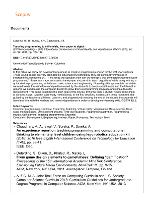Mostrar el registro sencillo del ítem
Teaching programming to millennials, from paper to digital
| dc.contributor.author | Bautista Lasprilla, Gloria Isabel | |
| dc.contributor.author | Henriquez Nuñez, Yuranis | |
| dc.contributor.author | Serrano Castañeda, Jairo | |
| dc.date.accessioned | 2023-07-18T19:35:30Z | |
| dc.date.available | 2023-07-18T19:35:30Z | |
| dc.date.issued | 2019-11 | |
| dc.date.submitted | 2023-07 | |
| dc.identifier.citation | Lasprilla, G.I.B., Nunez, Y.H., Castaneda, J.S. Teaching programming to millennials, from paper to digital (2019) Proceedings - 2019 International Conference on Virtual Reality and Visualization, ICVRV 2019, art. no. 9212918, pp. 129-132. DOI: 10.1109/ICVRV47840.2019.00030 | spa |
| dc.identifier.uri | https://hdl.handle.net/20.500.12585/12150 | |
| dc.description.abstract | In this article we show the development process to create a programming course for the first-year students. These young people are very prompt to be influenced by technology, they are constantly immersed in smartphones, connected 24/7. This raises the question; how can we interest a well-connected student to learn programming? Some years ago, we used to have paper and pencil to teach 'algorithms' while trying to bring a quick start to programming activities on basic science and engineering. Nowadays this approach is not viable, we need to use the same tools and platforms used by the students to access social media and the Internet in general, we need to use the computer directly to show them a programming language and simple tools for development. This paper describes the main goal of this course, bring the tools a student needs from simple to complex stage, based in case study methodology. In the first sessions, students are being monitored and guided by the teacher at all times. Later on, and progressively reaching the end of the course, the students will have less time with the teachers and more independence in order to develop self-learning skills. | spa |
| dc.format.extent | 4 páginas | |
| dc.format.mimetype | application/pdf | spa |
| dc.language.iso | eng | spa |
| dc.rights.uri | http://creativecommons.org/licenses/by-nc-nd/4.0/ | * |
| dc.source | Proceedings - 2019 International Conference on Virtual Reality and Visualization, ICVRV 2019 | spa |
| dc.title | Teaching programming to millennials, from paper to digital | spa |
| dcterms.bibliographicCitation | Chaudhary, V., Agrawal, V., Sureka, P., Sureka, A. An Experience Report on Teaching Programming and Computational Thinking to Elementary Level Children Using Lego Robotics Education Kit (2016) Proceedings - IEEE 8th International Conference on Technology for Education, T4E 2016, art. no. 7814791, pp. 38-41. Cited 39 times. ISBN: 978-150906115-0 doi: 10.1109/T4E.2016.016 | spa |
| dcterms.bibliographicCitation | Deterding, S., Dixon, D., Khaled, R., Nacke, L. From game design elements to gamefulness: Defining "gamification" (2011) Proceedings of the 15th International Academic MindTrek Conference: Envisioning Future Media Environments, MindTrek 2011, pp. 9-15. Cited 4554 times. ISBN: 978-145030816-8 doi: 10.1145/2181037.2181040 | spa |
| dcterms.bibliographicCitation | A. f. C. M. A. Joint Task Force on Computing Curricula and I. C. Society. Computer Science Curricula 2013: Curriculum Guidelines for Undergraduate Degree Programs in Computer Science. ACM, New York, NY, USA, 2013 | spa |
| dcterms.bibliographicCitation | Linn, M.C., Clancy, M.J. The Case for Case Studies of Programming Problems (Open Access) (1992) Communications of the ACM, 35 (3), pp. 121-132. Cited 167 times. doi: 10.1145/131295.131301 | spa |
| dcterms.bibliographicCitation | Malik, S.I., Coldwell-Neilson, J. A model for teaching an introductory programming course using ADRI (Open Access) (2017) Education and Information Technologies, 22 (3), pp. 1089-1120. Cited 56 times. http://www.kluweronline.com/issn/1360-2357 doi: 10.1007/s10639-016-9474-0 | spa |
| dcterms.bibliographicCitation | Pérez, F., Granger, B.E. IPython: A system for interactive scientific computing (2007) Computing in Science and Engineering, 9 (3), art. no. 4160251, pp. 21-29. Cited 2685 times. doi: 10.1109/MCSE.2007.53 | spa |
| dcterms.bibliographicCitation | Watson, C., Li, F.W.B. Failure rates in introductory programming revisited (2014) ITICSE 2014 - Proceedings of the 2014 Innovation and Technology in Computer Science Education Conference, pp. 39-44. Cited 359 times. ISBN: 978-145032833-3 doi: 10.1145/2591708.2591749 | spa |
| datacite.rights | http://purl.org/coar/access_right/c_abf2 | spa |
| oaire.version | http://purl.org/coar/version/c_b1a7d7d4d402bcce | spa |
| dc.type.driver | info:eu-repo/semantics/article | spa |
| dc.type.hasversion | info:eu-repo/semantics/draft | spa |
| dc.identifier.doi | 10.1109/ICVRV47840.2019.00030 | |
| dc.subject.keywords | Algorithms | spa |
| dc.subject.keywords | Programming | spa |
| dc.subject.keywords | Python Computer Science Engineering | spa |
| dc.subject.keywords | Teaching | spa |
| dc.rights.accessrights | info:eu-repo/semantics/openAccess | spa |
| dc.rights.cc | Attribution-NonCommercial-NoDerivatives 4.0 Internacional | * |
| dc.identifier.instname | Universidad Tecnológica de Bolívar | spa |
| dc.identifier.reponame | Repositorio Universidad Tecnológica de Bolívar | spa |
| dc.publisher.place | Cartagena de Indias | spa |
| dc.type.spa | http://purl.org/coar/resource_type/c_6501 | spa |
| oaire.resourcetype | http://purl.org/coar/resource_type/c_2df8fbb1 | spa |
Ficheros en el ítem
Este ítem aparece en la(s) siguiente(s) colección(ones)
-
Productos de investigación [1453]
Universidad Tecnológica de Bolívar - 2017 Institución de Educación Superior sujeta a inspección y vigilancia por el Ministerio de Educación Nacional. Resolución No 961 del 26 de octubre de 1970 a través de la cual la Gobernación de Bolívar otorga la Personería Jurídica a la Universidad Tecnológica de Bolívar.













